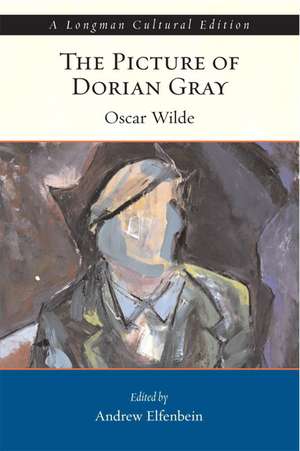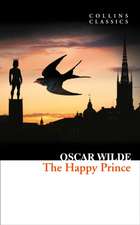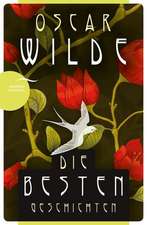The Picture of Dorian Gray: Longman Cultural Editions
Autor Oscar Wilde, Andrew Elfenbeinen Limba Engleză Paperback – 30 sep 2006
Preț: 250.32 lei
Nou
Puncte Express: 375
Preț estimativ în valută:
47.91€ • 52.06$ • 40.27£
47.91€ • 52.06$ • 40.27£
Carte disponibilă
Livrare economică 31 martie-14 aprilie
Preluare comenzi: 021 569.72.76
Specificații
ISBN-13: 9780321427137
ISBN-10: 0321427130
Pagini: 345
Dimensiuni: 142 x 210 x 17 mm
Greutate: 0.4 kg
Ediția:1
Editura: Pearson
Seria Longman Cultural Editions
Locul publicării:New York, United States
ISBN-10: 0321427130
Pagini: 345
Dimensiuni: 142 x 210 x 17 mm
Greutate: 0.4 kg
Ediția:1
Editura: Pearson
Seria Longman Cultural Editions
Locul publicării:New York, United States
Descriere
From Longman's new Cultural Editions Series, Oscar Wilde's The Picture of Dorian Gray, edited by Andrew Elfenbein, includes the novel and contextual materials from the era of Oscar Wilde.
This edition of Oscar Wilde's classic work, The Picture of Dorian Gray, highlights the novel's modernity in both its form and its revolutionary content, and traces its links to modernist literature and the culture of modernity alike.
Previous editions of the novel have only seen it in a late Victorian context, or as an extension of the aesthetic theories of Walter Pater and the “art for art's sake” movement. As presented in this new edition, however, the freshness and originality of the book emerges, along with its strong social messages. The book is a pastiche of genres that propels nineteenth-century realism into twentieth-century modernism ahead of its own time. Wilde's novel offers a myth for modernity whose hold on the cultural imagination has only strengthened over time-Dorian Gray's uncanny bond with his own portrait underscores the loss of selfhood everyone experiences in a world of images and copies, paves the way for the discourses of homosexuality and the understanding of lifestyle as identity so current today, and provides clues to the mysteries of modern ethics and politics. The edition also emphasizes the role of gender and the rise of female emancipation underlying the Sybil Vane subplot, a focus on women that intensifies the book's relevance to modern transformations of men and women alike.
This edition of Oscar Wilde's classic work, The Picture of Dorian Gray, highlights the novel's modernity in both its form and its revolutionary content, and traces its links to modernist literature and the culture of modernity alike.
Previous editions of the novel have only seen it in a late Victorian context, or as an extension of the aesthetic theories of Walter Pater and the “art for art's sake” movement. As presented in this new edition, however, the freshness and originality of the book emerges, along with its strong social messages. The book is a pastiche of genres that propels nineteenth-century realism into twentieth-century modernism ahead of its own time. Wilde's novel offers a myth for modernity whose hold on the cultural imagination has only strengthened over time-Dorian Gray's uncanny bond with his own portrait underscores the loss of selfhood everyone experiences in a world of images and copies, paves the way for the discourses of homosexuality and the understanding of lifestyle as identity so current today, and provides clues to the mysteries of modern ethics and politics. The edition also emphasizes the role of gender and the rise of female emancipation underlying the Sybil Vane subplot, a focus on women that intensifies the book's relevance to modern transformations of men and women alike.
Cuprins
List of Illustrations
About Longman Cultural Editions
About This Edition
Introduction
Table of Dates
The Picture of Dorian Gray (1891)
Contexts
Textual Issues
The Two Versions of The Picture of Dorian Gray
from Chapter 1 (1890, 1891)
from Chapter 7 (1890) and Chapter 9 (1891)
from Chapter 10 (1890) and Chapter 12 (1891)
from Chapter 13 (1890) and Chapter 20 (1891)
Chapter 11: Further Annotations
Victorian Reactions to The Picture of Dorian Gray
Reviews
Ward, Lock, and Co., Lippincott's Advertisement for The Picture of Dorian Gray
Samuel Henry Jeyes, St. James's Gazette and Wilde's responses
Walter Pater, The Bookman
Paradies
Robert Smythe Hichens, from The Green Carnation
George Slythe Street, from The Autobiography of a Boy
Wilde's Trials
from Regina (Oscar Wilde) vs. John Douglas (Marquess of Queensberry)
Aestheticism
Walter Pater, "Conclusion" to The Renaissance
Mathew Arnold, from Culture and Anarchy
Oscar Wilde, from The Decay of Lying
Joris-Karl Huysmans, from A Rebours (Against the Grain)
Science
Charles Darwin, from The Descent of Man
William Kingdon Clifford, from "Right and Wrong: The Scientific Ground of their Distinction"
Thomas Henry Huxley, from "Science and Culture"
Henry Maudsley, from The Physiology and Pathology of the Mind
Love between Men
John Addington Symonds, from "A Problem in Greek Ethics"
Richard St. John Tyrwhitt, from "The Greek Spirit in Modern Literature"
Havelock Ellis, from Sexual Inversion
Works Cited in the Notes
Further Reading
About Longman Cultural Editions
About This Edition
Introduction
Table of Dates
The Picture of Dorian Gray (1891)
Contexts
Textual Issues
The Two Versions of The Picture of Dorian Gray
from Chapter 1 (1890, 1891)
from Chapter 7 (1890) and Chapter 9 (1891)
from Chapter 10 (1890) and Chapter 12 (1891)
from Chapter 13 (1890) and Chapter 20 (1891)
Chapter 11: Further Annotations
Victorian Reactions to The Picture of Dorian Gray
Reviews
Ward, Lock, and Co., Lippincott's Advertisement for The Picture of Dorian Gray
Samuel Henry Jeyes, St. James's Gazette and Wilde's responses
Walter Pater, The Bookman
Paradies
Robert Smythe Hichens, from The Green Carnation
George Slythe Street, from The Autobiography of a Boy
Wilde's Trials
from Regina (Oscar Wilde) vs. John Douglas (Marquess of Queensberry)
Aestheticism
Walter Pater, "Conclusion" to The Renaissance
Mathew Arnold, from Culture and Anarchy
Oscar Wilde, from The Decay of Lying
Joris-Karl Huysmans, from A Rebours (Against the Grain)
Science
Charles Darwin, from The Descent of Man
William Kingdon Clifford, from "Right and Wrong: The Scientific Ground of their Distinction"
Thomas Henry Huxley, from "Science and Culture"
Henry Maudsley, from The Physiology and Pathology of the Mind
Love between Men
John Addington Symonds, from "A Problem in Greek Ethics"
Richard St. John Tyrwhitt, from "The Greek Spirit in Modern Literature"
Havelock Ellis, from Sexual Inversion
Works Cited in the Notes
Further Reading
Notă biografică
Andrew Elfenbein is the Morse-Alumni Distinguish Teaching Professor of English at the University of Minnesota. He works on 18th- and 19th-century British literature, gender and sexuality studies, the history of English, and cognitive approaches to reading.
Textul de pe ultima copertă
Oscar Wilde
Oscar Wilde’s The Picture of Dorian Gray
A Longman Cultural Edition
Editor: Andrew Elfenbein
Series Editor: Susan J. Wolfson Affordably priced, Longman Cultural Editions present classic works in provocative and illuminating contexts–cultural, critical, and literary. Each Longman Cultural Edition consists of the complete text of a key literary work, supplemented by helpful annotations and followed by contextual materials that reveal the conversations and controversies of its historical moment.
Other Longman Cultural Editions NEW! The Castle of Otranto and The Man of Feeling
Edited by Laura Mandell
© 2007 • Paper • ISBN 0-321-39892-0
NEW! Heart of Darkness, The Man Who Would Be King, and Other Works on Empire
Edited by David Damrosch
© 2007 • Paper • ISBN 0-321-36467-8
NEW! Frankenstein, Second Edition
Edited by Susan J. Wolfson
© 2007 • Paper • ISBN 0-321-39953-6
NEW! A Vindication of the Rights of Woman and The Wrongs of Woman, or Maria
Edited by Anne K. Mellor and Noelle Chao
© 2007 • Paper • ISBN 0-321-18273-1
Emma
Edited by Frances Ferguson
© 2006 • Paper • ISBN 0-321-22504-X
The Merchant of Venice
Edited by Lawrence Danson
© 2005 • Paper • ISBN 0-321-16419-9
King Lear
Edited by Claire McEachern
© 2005 • Paper • ISBN 0-321-10722-5
Northanger Abbey
Edited by Marilyn Gaull
© 2005 • Paper • ISBN 0-321-20208-2
Hard Times
Edited by Jeffrey Nunokawa and Gage McWeeny
© 2005 • Paper • ISBN 0-321- 10721-7
Hamlet, Second Edition
Edited by Constance Jordan
© 2005 • Paper • ISBN 0-321-31729-7
Beowulf
Edited by Sarah Anderson, Translated Alan Sullivan and Timothy Murphy
© 2004 • Paper • ISBN 0-321-10720-9
Othello and The Tragedy of Mariam
Edited by Clare Carroll
© 2003 • Paper • ISBN 0-321-09699-1
Pride and Prejudice
Edited by Claudia L. Johnson and Susan J. Wolfson
© 2003 • Paper • ISBN 0-321-10507-9
Coming Soon!
Henry IV, Parts I & II
Edited by Ronald Levao
© 2007 • Paper • ISBN 0-321-18274-X
John Keats
Edited by Susan Wolfson
© 2007 • Paper • ISBN 0-321-23616-5
Oscar Wilde’s The Picture of Dorian Gray
A Longman Cultural Edition
Editor: Andrew Elfenbein
Series Editor: Susan J. Wolfson Affordably priced, Longman Cultural Editions present classic works in provocative and illuminating contexts–cultural, critical, and literary. Each Longman Cultural Edition consists of the complete text of a key literary work, supplemented by helpful annotations and followed by contextual materials that reveal the conversations and controversies of its historical moment.
Other Longman Cultural Editions NEW! The Castle of Otranto and The Man of Feeling
Edited by Laura Mandell
© 2007 • Paper • ISBN 0-321-39892-0
NEW! Heart of Darkness, The Man Who Would Be King, and Other Works on Empire
Edited by David Damrosch
© 2007 • Paper • ISBN 0-321-36467-8
NEW! Frankenstein, Second Edition
Edited by Susan J. Wolfson
© 2007 • Paper • ISBN 0-321-39953-6
NEW! A Vindication of the Rights of Woman and The Wrongs of Woman, or Maria
Edited by Anne K. Mellor and Noelle Chao
© 2007 • Paper • ISBN 0-321-18273-1
Emma
Edited by Frances Ferguson
© 2006 • Paper • ISBN 0-321-22504-X
The Merchant of Venice
Edited by Lawrence Danson
© 2005 • Paper • ISBN 0-321-16419-9
King Lear
Edited by Claire McEachern
© 2005 • Paper • ISBN 0-321-10722-5
Northanger Abbey
Edited by Marilyn Gaull
© 2005 • Paper • ISBN 0-321-20208-2
Hard Times
Edited by Jeffrey Nunokawa and Gage McWeeny
© 2005 • Paper • ISBN 0-321- 10721-7
Hamlet, Second Edition
Edited by Constance Jordan
© 2005 • Paper • ISBN 0-321-31729-7
Beowulf
Edited by Sarah Anderson, Translated Alan Sullivan and Timothy Murphy
© 2004 • Paper • ISBN 0-321-10720-9
Othello and The Tragedy of Mariam
Edited by Clare Carroll
© 2003 • Paper • ISBN 0-321-09699-1
Pride and Prejudice
Edited by Claudia L. Johnson and Susan J. Wolfson
© 2003 • Paper • ISBN 0-321-10507-9
Coming Soon!
Henry IV, Parts I & II
Edited by Ronald Levao
© 2007 • Paper • ISBN 0-321-18274-X
John Keats
Edited by Susan Wolfson
© 2007 • Paper • ISBN 0-321-23616-5
Caracteristici
- Detailed footnotes on each page annotate unfamiliar references.
- First reviews of the novel illustrate the controversy of its time.
- Excerpts on Victorian aestheticism and Victorian sexuality illuminate the novel’s response to Victorian aestheticism and Wilde’s representation of sexuality.
- Introductory chronology of dates places the novel in historical context.
- Editor’s introduction offers a critical analysis of the text.
- Parodies of the text demonstrate humor in aestheticism.








